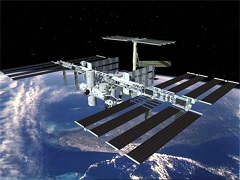UM in Orbit. / November 5, 2013 /
 |
The orbital science will breathe freely soon – the International Space Station is awaiting the reinforcement eagerly. The Nauka Multipurpose Laboratory Module is at the final stage of preparation.
A. Kuznetsov, Deputy Chief Designer, S.P. Korolev Rocket and Space Corporation „ENERGIA“ said, „The MLM is under electrical testing now. This is a passive combined and very complicated subassembly unit that has been developed for the Module. Just below is the docking unit to which the air lock will join with to equip completely the MLM that will enable the experiment payloads to be positioned outside with no extra-vehicular excursion.“
An additional cabin, bathroom unit, and a large room for new scientific experiments both indoors and outdoors. On the outer side, the European Robotic Arm and an experimental airlock will be mounted to carry out experiments without any exit into the outer space. However the orbital station will not be completed by this. In the mid of next year, the Nodal Module (UM) is scheduled for launch. The engineers joke that the orbital home is unwell without the UM (Russian: „Mind“ or „Brain“).
„This module is the next stage of the ISS Russian Segment development. Upon launching the MLM, the next to be developed will be the Power Module and additional ports, berths for implementing scientific research program,“ tells A. Strekalov, the First Vice-President of RKK ENERGIA, Director General of the Experimental Machine Building Plant.
This is the first stage towards a new principle of the orbital station construction or modernization. Together with one more prospective module – Science-Power Module (NEM) UM will become a key element of any space infrastructure. This is a universal tandem for a future conquest of outer space.
„These are two modules and this is the first Node Module – they allow a construction of practically any space infrastructure including an extraterrestrial one,“ says N. Bryukhanov, the First Deputy Chief Designer of RKK ENERGIA.
The sphere with six docking assemblies – nodes. A large number of connecting elements, pipelines – all of these to transfer from one module to another. Electricity, oxygen, and propellant components, not to mention the data. Thus the Module is literally braided with wires outside like web. „Here one can see an attachment ring for one docking unit, and the attachment rings for five other docking unites are seen. Now the module interior is being mounted,“ N. Bryuykhanov tells about the Module.
For the present there are only large holes instead of docking assemblies. The docking units will be mounted on these rings that will allow spacecraft – manned and supply and even the cluster of modules to be docked. Inside is the supplies space and corridor from one module to another.
„There was installed some equipment and astronauts will travel through this module when, speaking figuratively, the Module arrives then the same NEM will arrive or spacecraft that will dock there,“ says A. Strekalov.
At RKK ENERGIA N. Bryukhanov is a manager of practically all manned spaceflight programs. He recalls that such module has already existed – at the MIR Space Station, but this one is improved with due account for all requirements.
„MIR Space Station: we had to deorbit it because all structure elements had worked 15 years in space and were beyond its warranty lifetime. There was the analog of such element, but it was the part of the baseline unit. It was attached tightly to the unit and we could not change the baseline unit because the similar unit was a belonging of the unit. We can change any module in the same configuration whatever the station structure is,“ tells N. Bryukhanov.
When developing the UM module (Node), the new solutions have been developed. The astronauts’ wishes are limited more frequently to the interior. The interior of the Node Module will be different.
«Here there will be realized, say, inner interiors which are made of non-fabric materials. For today, this is one of the aging problems existing in the flying complex,“ tells A. Strekalov.
The Node Module together with instrument-assembly module will weigh more than 8 tons. UM will be launched by the Soyuz carrier rocket in the middle of next year. As predicted, such construction will exist in aggressive space approximately 30 years. This period will allow the orbital house to be modernized and the human outpost in space to be completed. TV studio of ROSCOSMOS
Print version
|




